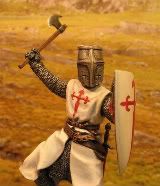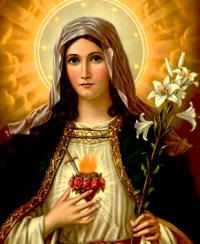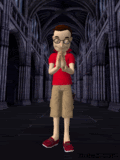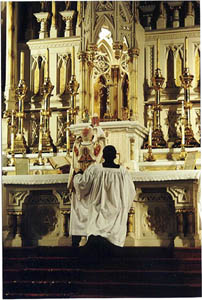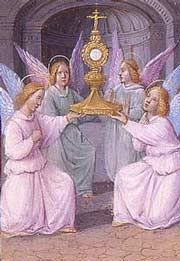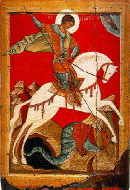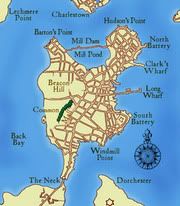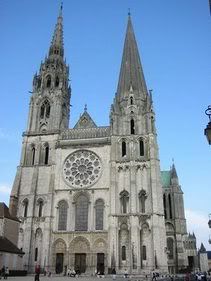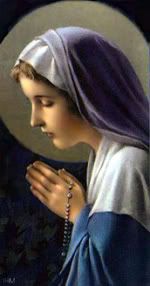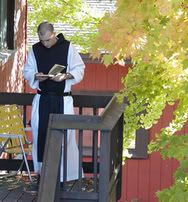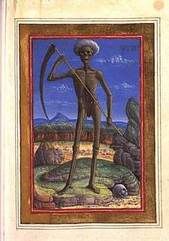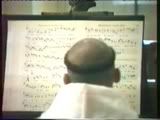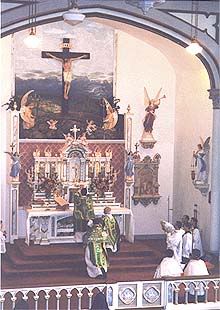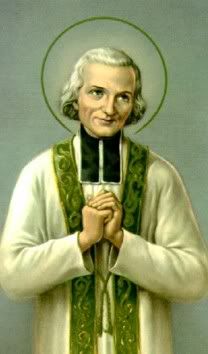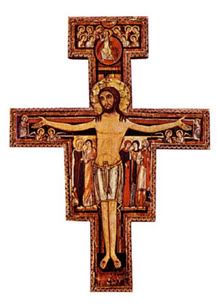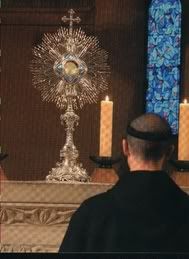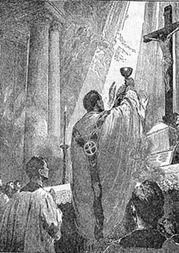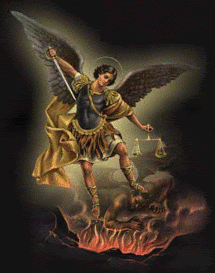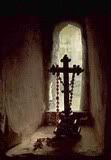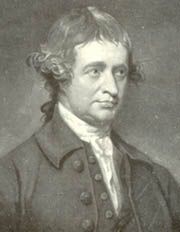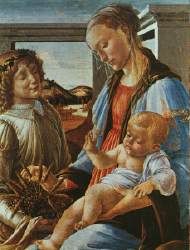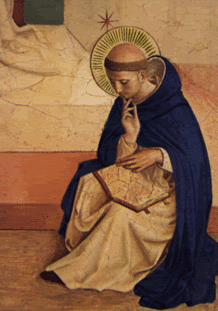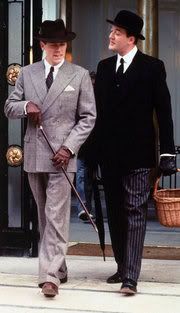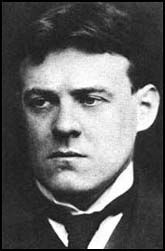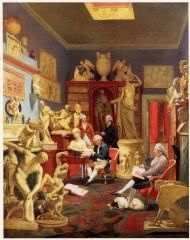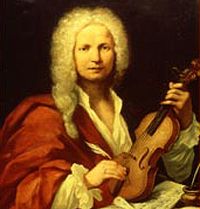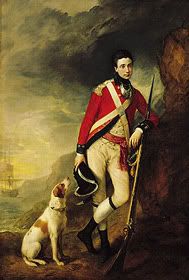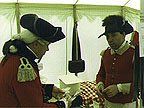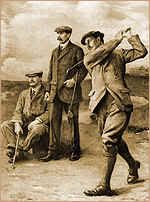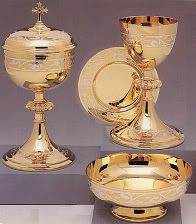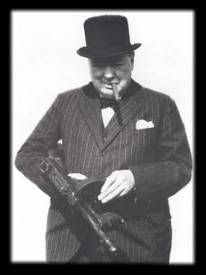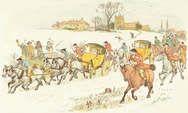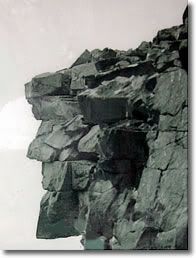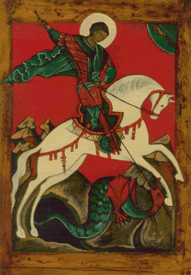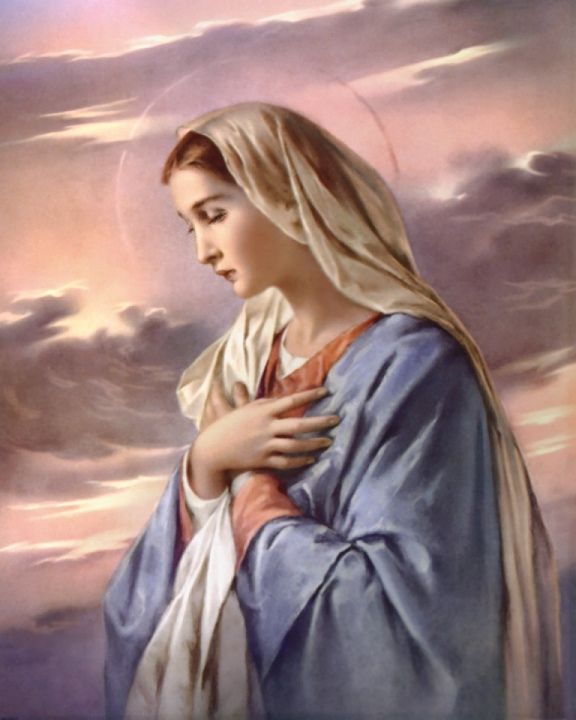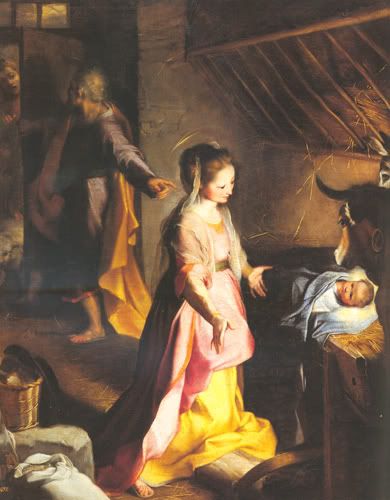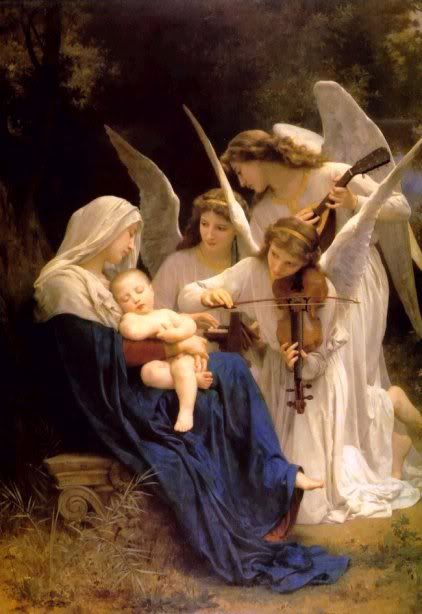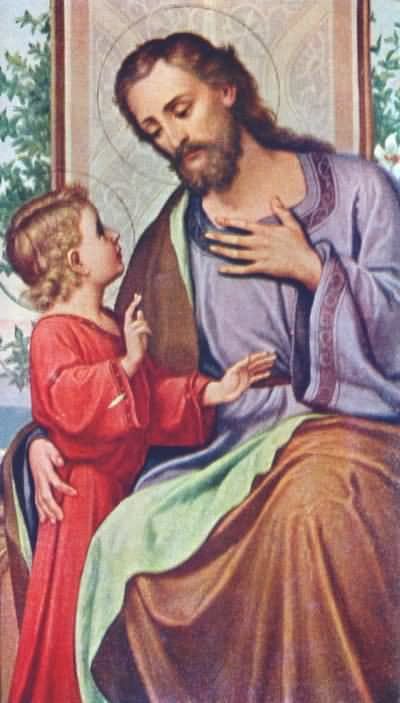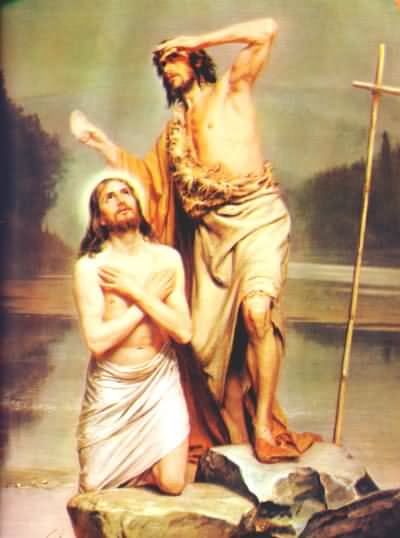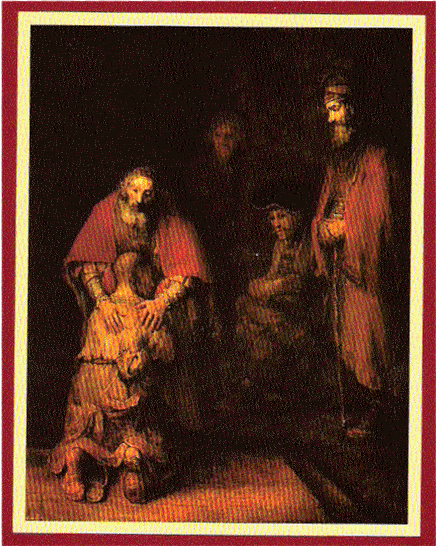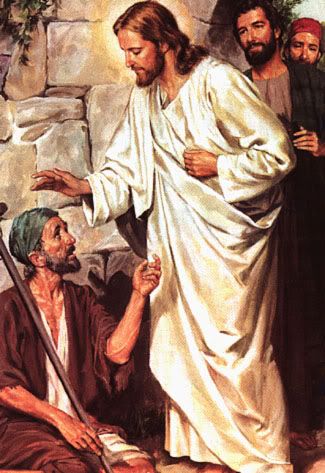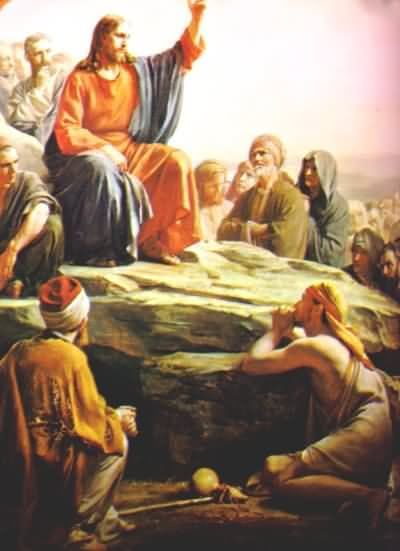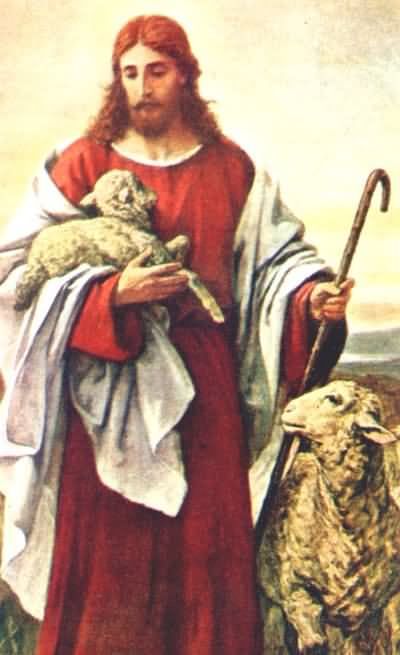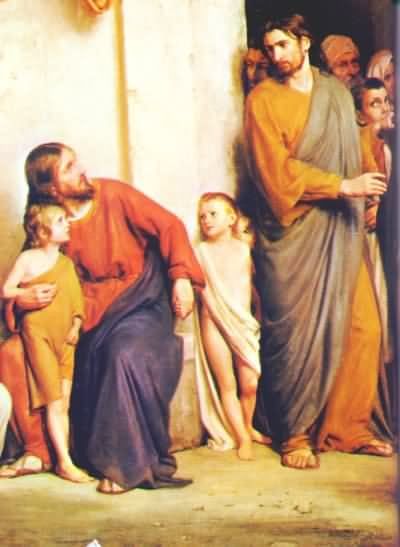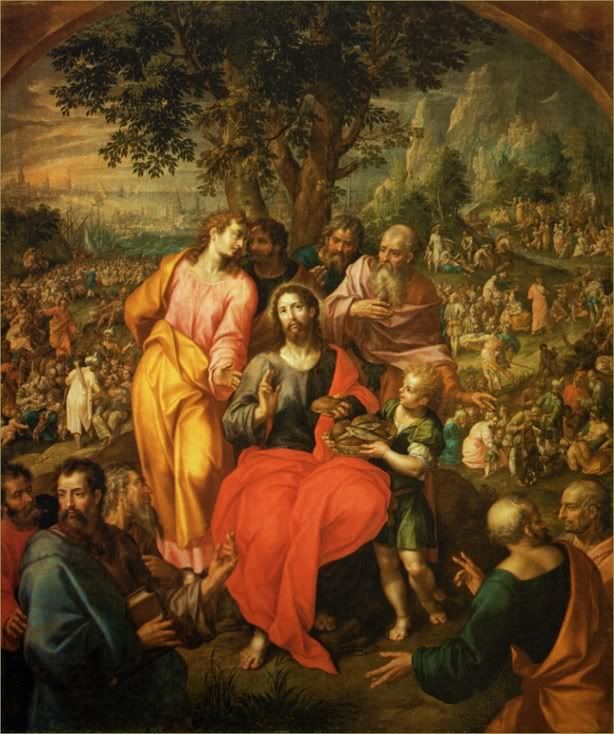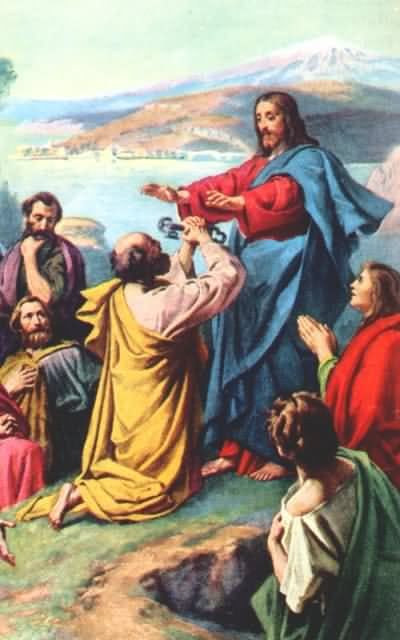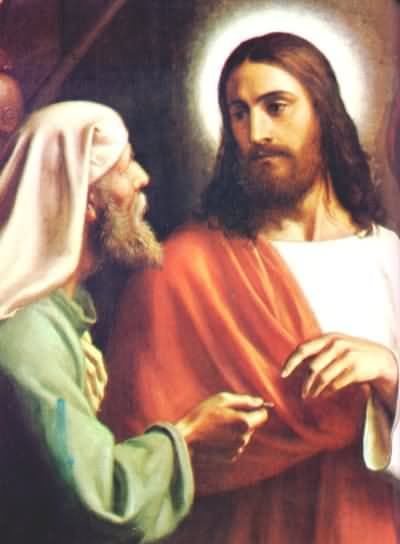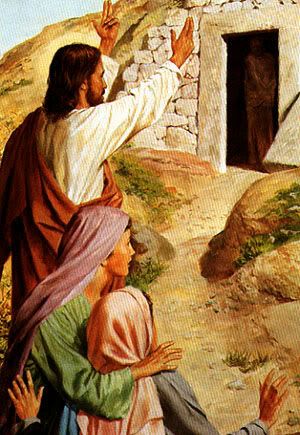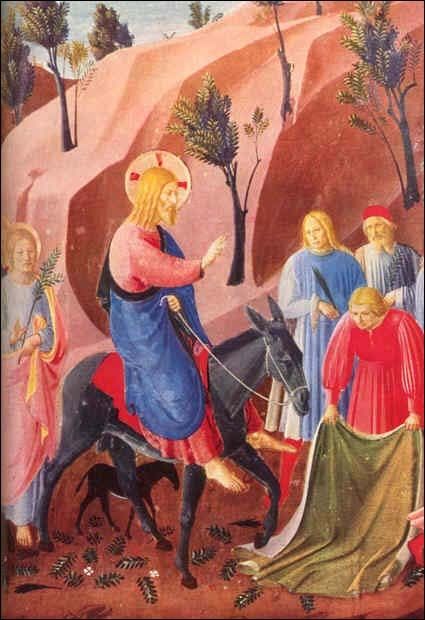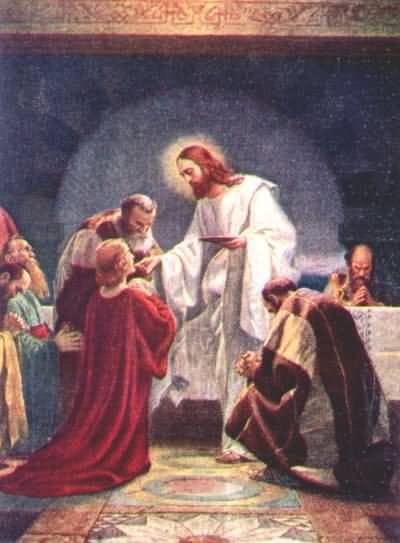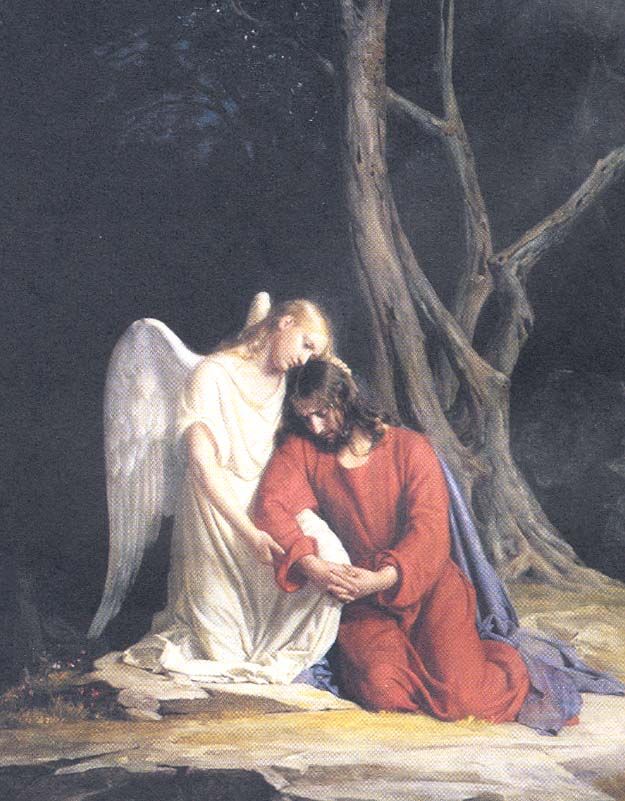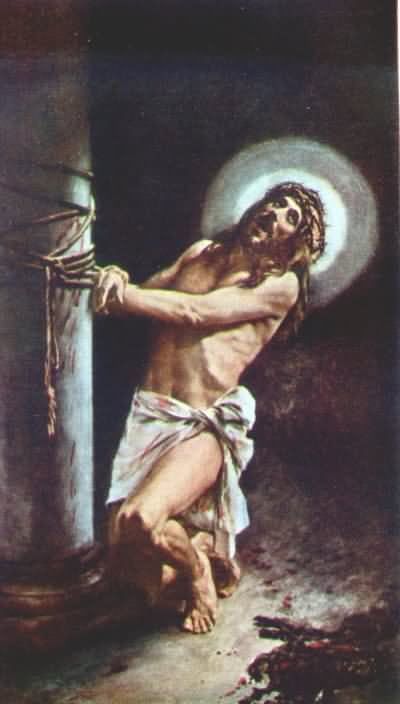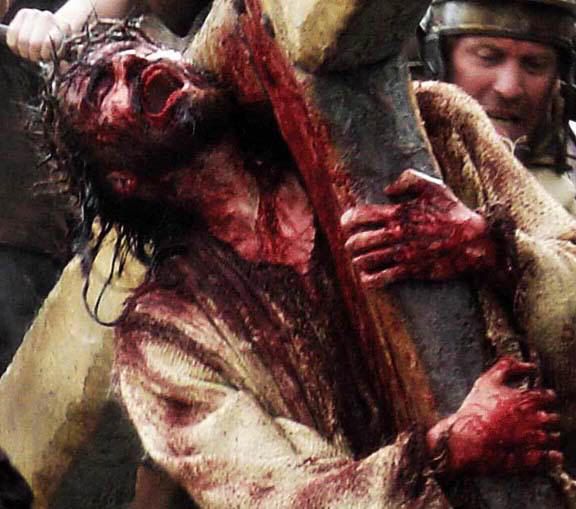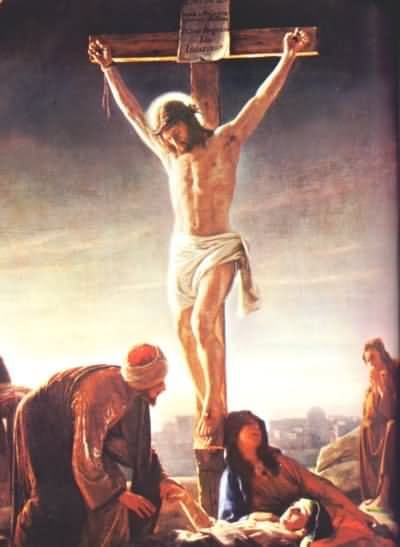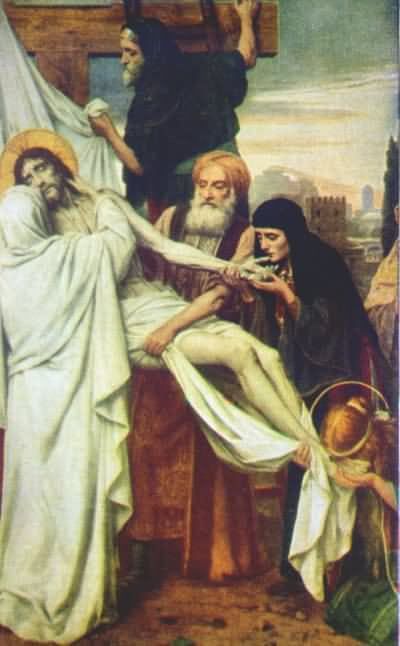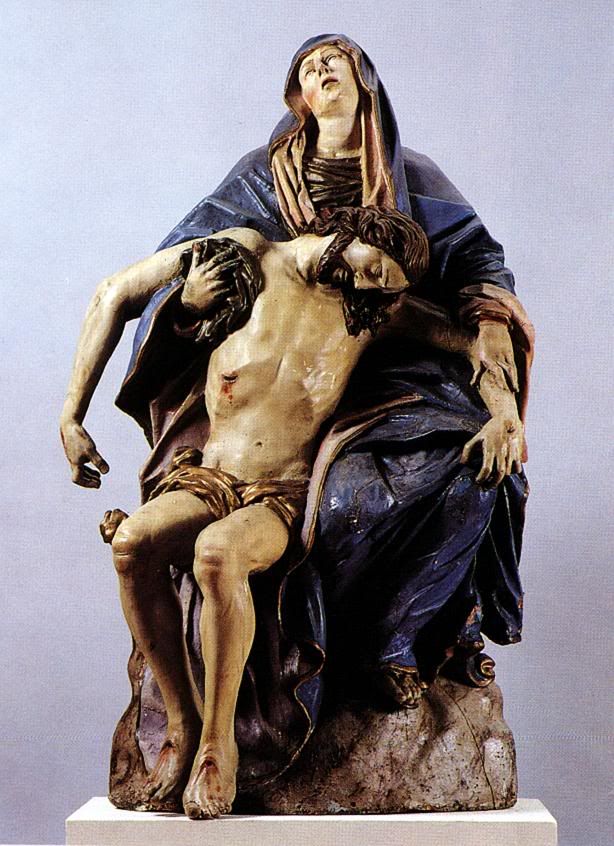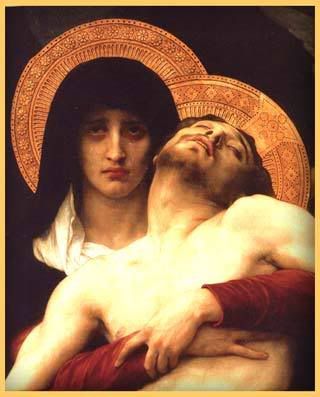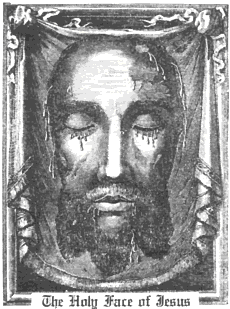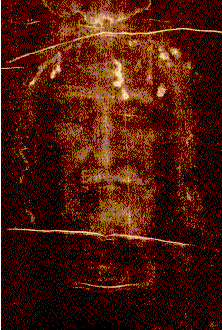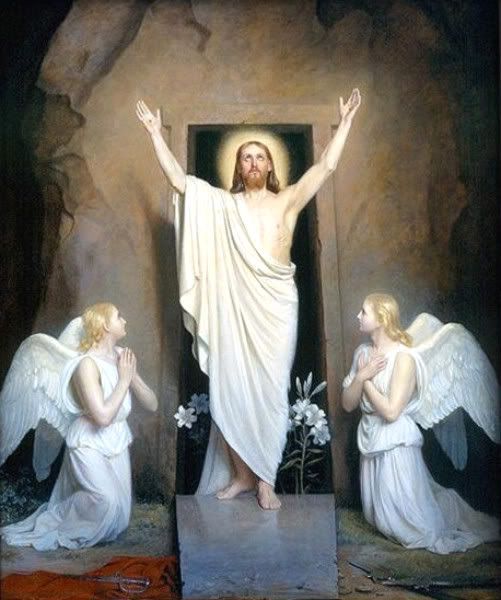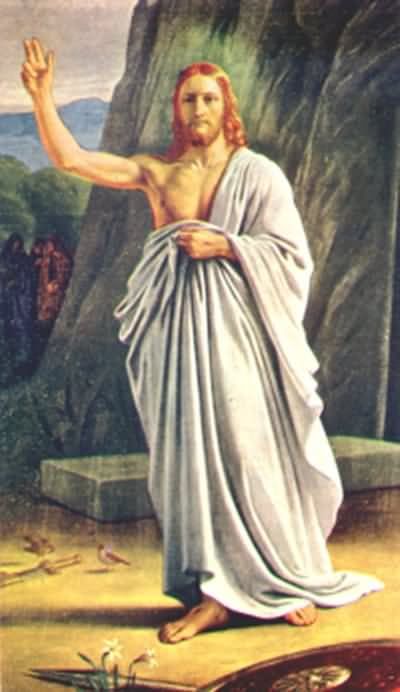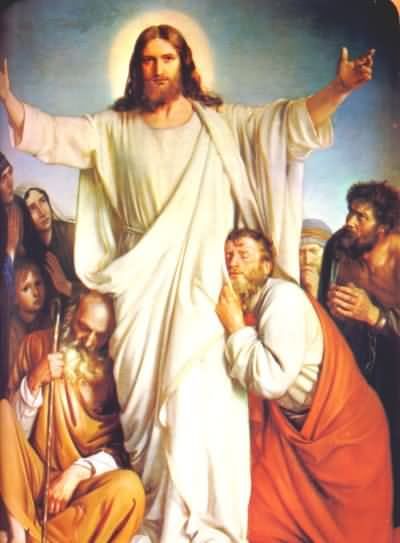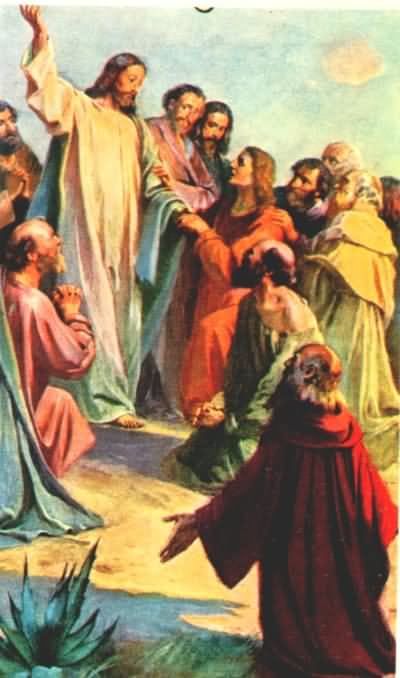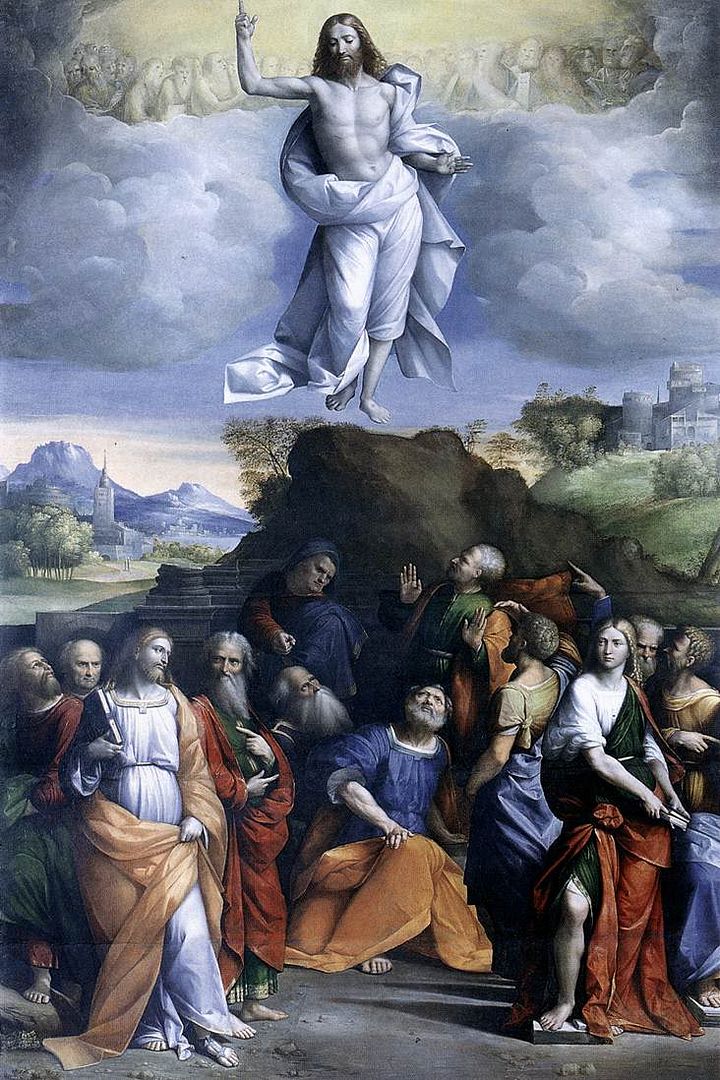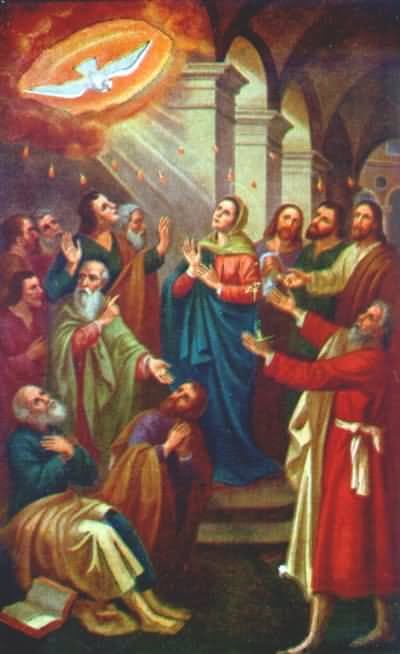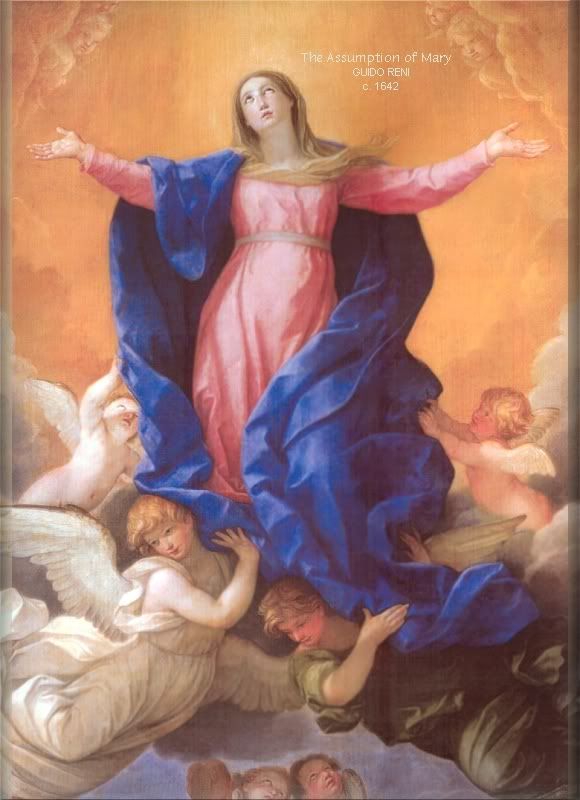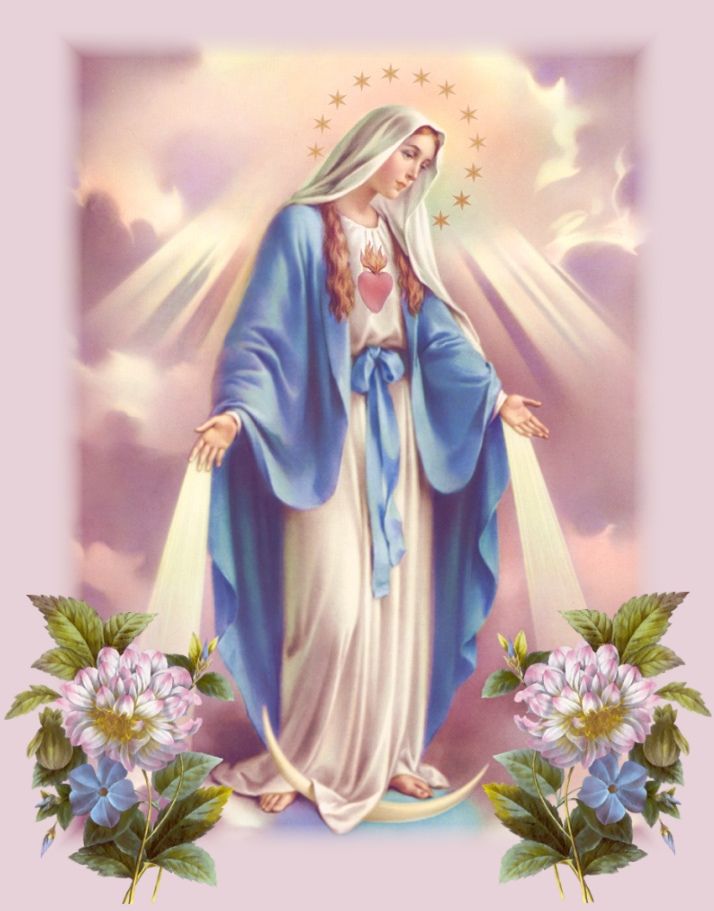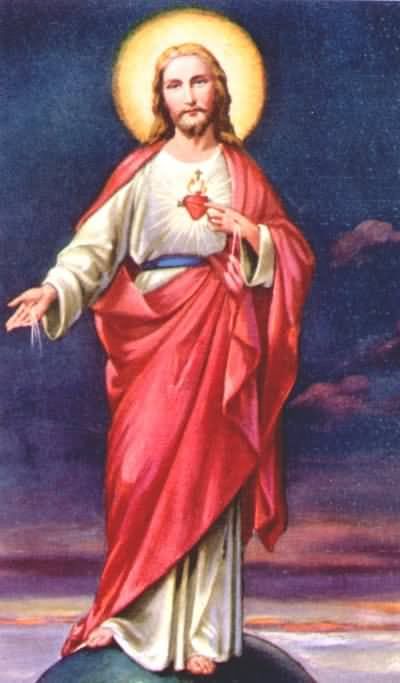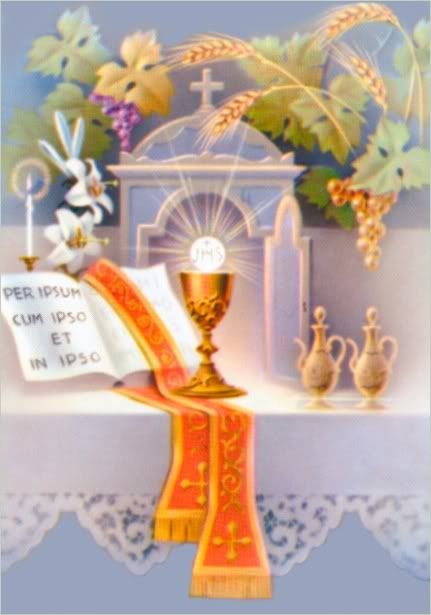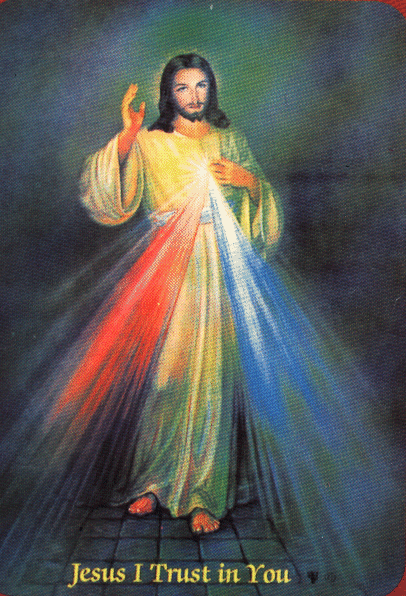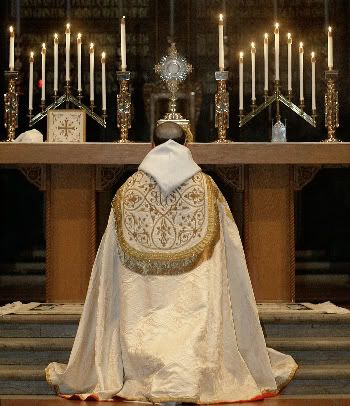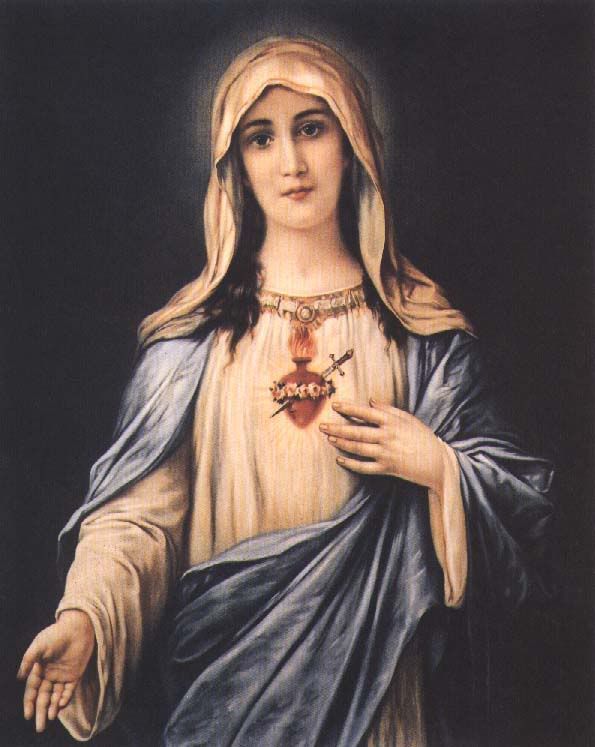Saturday, March 10, 2007
Saturday Of the Second Week In Lent
Station Church: Ss. Marcellino e Pietro al Laterano
Devotions for a Lenten Saturday holy hour:
Divine Mercy Chaplet
Seven Penitential Psalms
Prayer of St. Thomas More
Threnus Prayer of Saint Augustine
Stabat Mater Dolorosa
Litany of Our Lady of Sorrows
Sorrowful Mysteries
Devotions for a Lenten Saturday holy hour:
Divine Mercy Chaplet
Seven Penitential Psalms
Prayer of St. Thomas More
Threnus Prayer of Saint Augustine
Stabat Mater Dolorosa
Litany of Our Lady of Sorrows
Sorrowful Mysteries
Friday, March 09, 2007
Arma Christi Images
Sometimes called the Instruments of the Passion, sometimes involving Angels holding the items associated with the Passion, sometimes also with Our Lord as the Man of Sorrows, sometimes just the items alone. These devotional images and items were once (and maybe will be one day again) major elements of Catholic devotional life.

This one is vary familiar to long-time Recta Ratio readers, as I scanned it in from a book about the Hours of Henry VIII (Jean Poyet) and used it as a banner image, along with flanking images of St. Jerome and Job in penance. This introduced me to the Arma Christi, the Mass of St. Gregory, and the Man of Sorrows. And I love the colors, the bright royal blue and the gold.
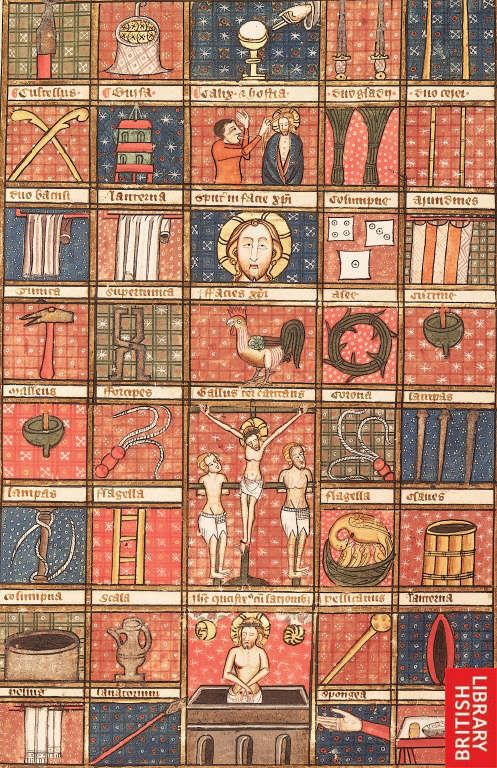
I found this medieval rendering of the instruments of the Passion while checking through the British Library website.
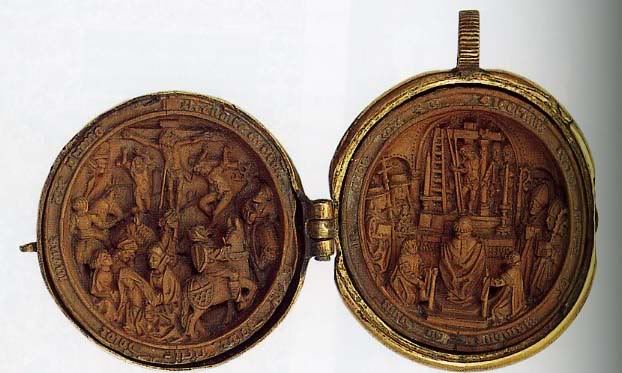
This little item is a Pater Noster bead from a rosary, which opens up to reveal the Sacrifice on Calvary, juxtaposed with the Sacrifice of the Mass (in this case, the Mass of Saint Gregory).
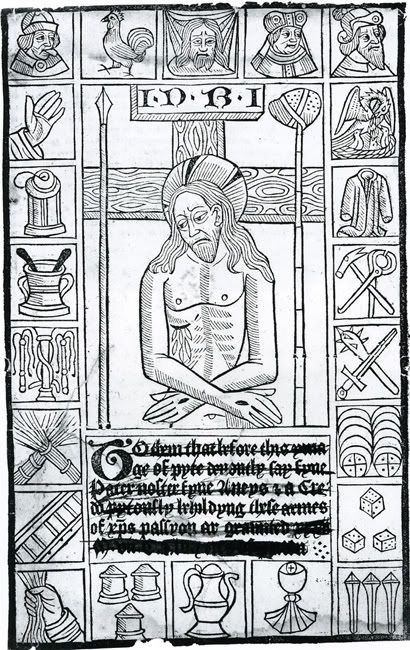
This medieval woodcut shows the various items associated with the Passion, with the Man of Sorrows in the center. Notice that later protestant rebels lined out the rubric giving the indulgence for saying the prescribed prayer before the image of the Man of Sorrows. As a lenten activity for young Catholic families, you might want to print out this image, and give it to the kids, to see if they can identify the various items associated with the Passion depicted therein.

The university website I found this at also supplied a nice answer key, in case young Catholic parents might not know what the Instruments of the Passion are themselves.

German roadside Crucifix with the Arma Christi. Would that people who erect roadside crosses here at the site of the death of a loved one would, instead of strewing it with flowers, pay a little extra to erect such a much more fitting memorial, one that associates their loved one's sufferings and death with Our Lord's.
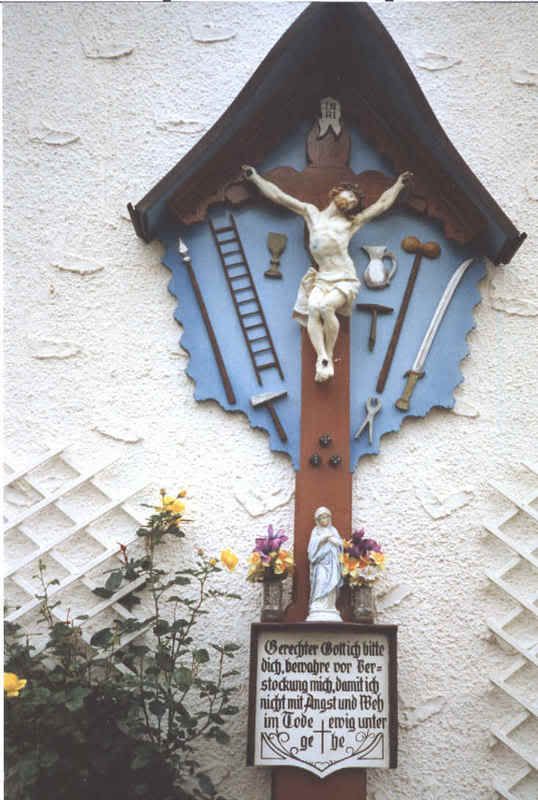
Another German Arma Christi Crucifix, but this one is not a roadside shrine.
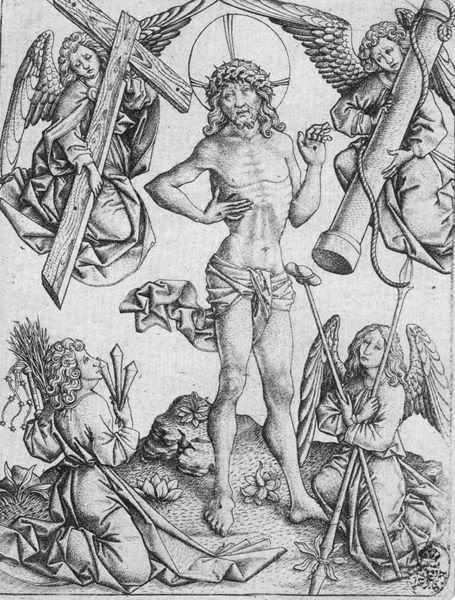
In this late-medieval German print, Our Lord appears as the Man of Sorrows, and Angels hold the Arma Christi.

This one is really cool. A Calvary Group, with all the Arma Christi on our Lord's Cross, and miniaturized in a bottle, no less.

You know I am fond of the Spanish Penitents. Here is one guild processing during Holy Week, with a Crucifix with the Arma Christi. BTW, I found a lotmore images of Spanish Penitents, and will be publishing a post on them later in Lent.
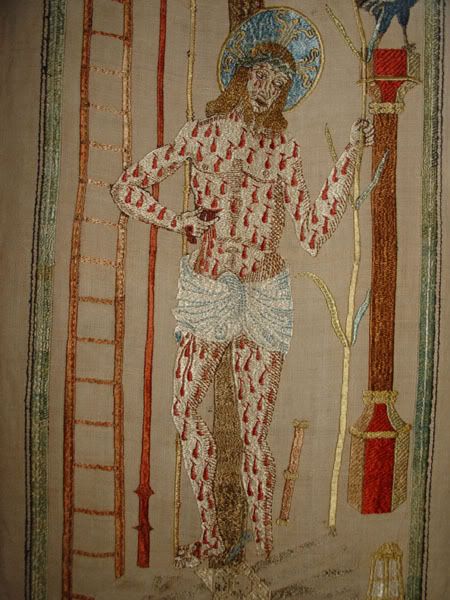
While doing some research on Margery Kempe, I came across an Arma Christi Roll, an illustrated poem about the Passion. Included in the Huntington Library's discussion of that poem is the Fetternear Processional Banner, which was made about 1520. Notice how very much like the Crucifix at St. Peter's in Harper's Ferry, WV which we discussed last Sunday this image is.
Update:
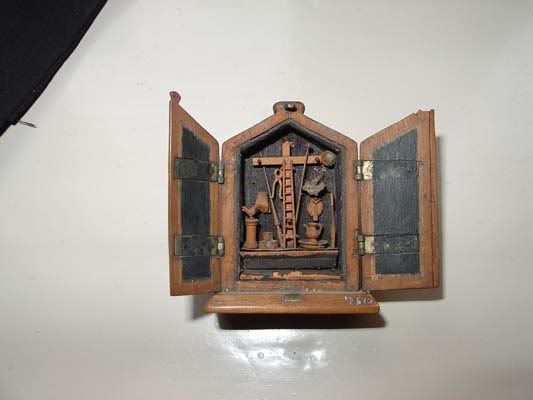
This final image I was searching for on Friday, but could not find in time. It was featured in an exhibit on English Catholics during penals days. It is a 2-inch high shrine carved in 1623 by a Thomas Lusher, a student at a Jesuit school for Englishmen in France, and meant to be carried on the person. Remember, this is 20 years or so after the Elizabethan persecution, and 20 years before Cromwell's.

This one is vary familiar to long-time Recta Ratio readers, as I scanned it in from a book about the Hours of Henry VIII (Jean Poyet) and used it as a banner image, along with flanking images of St. Jerome and Job in penance. This introduced me to the Arma Christi, the Mass of St. Gregory, and the Man of Sorrows. And I love the colors, the bright royal blue and the gold.

I found this medieval rendering of the instruments of the Passion while checking through the British Library website.

This little item is a Pater Noster bead from a rosary, which opens up to reveal the Sacrifice on Calvary, juxtaposed with the Sacrifice of the Mass (in this case, the Mass of Saint Gregory).

This medieval woodcut shows the various items associated with the Passion, with the Man of Sorrows in the center. Notice that later protestant rebels lined out the rubric giving the indulgence for saying the prescribed prayer before the image of the Man of Sorrows. As a lenten activity for young Catholic families, you might want to print out this image, and give it to the kids, to see if they can identify the various items associated with the Passion depicted therein.

The university website I found this at also supplied a nice answer key, in case young Catholic parents might not know what the Instruments of the Passion are themselves.

German roadside Crucifix with the Arma Christi. Would that people who erect roadside crosses here at the site of the death of a loved one would, instead of strewing it with flowers, pay a little extra to erect such a much more fitting memorial, one that associates their loved one's sufferings and death with Our Lord's.

Another German Arma Christi Crucifix, but this one is not a roadside shrine.

In this late-medieval German print, Our Lord appears as the Man of Sorrows, and Angels hold the Arma Christi.

This one is really cool. A Calvary Group, with all the Arma Christi on our Lord's Cross, and miniaturized in a bottle, no less.

You know I am fond of the Spanish Penitents. Here is one guild processing during Holy Week, with a Crucifix with the Arma Christi. BTW, I found a lotmore images of Spanish Penitents, and will be publishing a post on them later in Lent.

While doing some research on Margery Kempe, I came across an Arma Christi Roll, an illustrated poem about the Passion. Included in the Huntington Library's discussion of that poem is the Fetternear Processional Banner, which was made about 1520. Notice how very much like the Crucifix at St. Peter's in Harper's Ferry, WV which we discussed last Sunday this image is.
Update:

This final image I was searching for on Friday, but could not find in time. It was featured in an exhibit on English Catholics during penals days. It is a 2-inch high shrine carved in 1623 by a Thomas Lusher, a student at a Jesuit school for Englishmen in France, and meant to be carried on the person. Remember, this is 20 years or so after the Elizabethan persecution, and 20 years before Cromwell's.
Friday of the Second Week In Lent
Station Church: S. Vitale in Fovea
Devotions For A Lenten Friday Holy Hour:
Dies Irae
Divine Mercy Chaplet
Seven Penitential Psalms
Prayer of St. Thomas More
Threnus Prayer of Saint Augustine
Devotions To the Holy Cross
Stations of the Cross
Devotions For A Lenten Friday Holy Hour:
Dies Irae
Divine Mercy Chaplet
Seven Penitential Psalms
Prayer of St. Thomas More
Threnus Prayer of Saint Augustine
Devotions To the Holy Cross
Stations of the Cross
Thursday, March 08, 2007
Thursday Of the Second Week In Lent
Station Church: S. Maria in Trastevere
Devotions for a Lenten Thursday holy hour:
Dies Irae
Divine Mercy Chaplet
Seven Penitential Psalms
Prayer of St. Thomas More
Threnus Prayer of Saint Augustine
Devotion To the Holy Face
Devotions for a Lenten Thursday holy hour:
Dies Irae
Divine Mercy Chaplet
Seven Penitential Psalms
Prayer of St. Thomas More
Threnus Prayer of Saint Augustine
Devotion To the Holy Face
Well, Darn, the Stinking Murderous Communist Bastards In Red China Haven't Banned Recta Ratio Yet
Well, long live the free people of Taiwan!
Free Tibet!
Die, you murderous Commie scum, you deserve to roast in Hell eternally with Mao and all the other Communist butchers.
That should do the trick.
Free Tibet!
Die, you murderous Commie scum, you deserve to roast in Hell eternally with Mao and all the other Communist butchers.
That should do the trick.
Wednesday, March 07, 2007
Cold Enough To Freeze the Balls Off A Brass Monkey
You need to know something about naval vessels in the age of sail to understand that I said nothing even remotely offensive in the headline.
Beyond that, it is well below freezing here in Boston. The Charles River had been thawing out and melting, but it has refrozen, at least in the area near the MIT/Mass Ave Bridge. In fact, yesterday, when the high was supposed to be 19 (about 20 degrees below normal for this time in March) I watched the temperature get stuck at 7 degrees, with windchills in the -20 area all morning.
And it ain't much better today. And it won't be much better tomorrow, either. And Friday doesn't look too much better, as the revised forecast now says it won't even reach freezing then, despite earlier expectations of temperatures nearer 40.
Where is that groundhog? He deserves such a dope slap. Early Spring indeed!
Beyond that, it is well below freezing here in Boston. The Charles River had been thawing out and melting, but it has refrozen, at least in the area near the MIT/Mass Ave Bridge. In fact, yesterday, when the high was supposed to be 19 (about 20 degrees below normal for this time in March) I watched the temperature get stuck at 7 degrees, with windchills in the -20 area all morning.
And it ain't much better today. And it won't be much better tomorrow, either. And Friday doesn't look too much better, as the revised forecast now says it won't even reach freezing then, despite earlier expectations of temperatures nearer 40.
Where is that groundhog? He deserves such a dope slap. Early Spring indeed!
Wednesday Of the Second Week In Lent
Station Church: S. Cecilia in Trastevere
Devotions for a Lenten Wednesday holy hour:
Dies Irae
Divine Mercy Chaplet
Seven Penitential Psalms & the prayers against the Seven Deadly Sins
Prayer of St. Thomas More
Threnus Prayer
Seven Prayers of St. Gregory
Devotions for a Lenten Wednesday holy hour:
Dies Irae
Divine Mercy Chaplet
Seven Penitential Psalms & the prayers against the Seven Deadly Sins
Prayer of St. Thomas More
Threnus Prayer
Seven Prayers of St. Gregory
Tuesday, March 06, 2007
Tuesday of the Second Week In Lent
Station Church: S. Balbina all'Aventino
Devotions for a Lenten Tuesday Holy Hour:
Dies Irae
Divine Mercy Chaplet
Seven Penitential Psalms
Prayer of St. Thomas More
Threnus Prayer of Saint Augustine
Devotion of the Seven Last Words
Devotions for a Lenten Tuesday Holy Hour:
Dies Irae
Divine Mercy Chaplet
Seven Penitential Psalms
Prayer of St. Thomas More
Threnus Prayer of Saint Augustine
Devotion of the Seven Last Words
A Release Date!!!
No, sadly, not for the Motu Proprio on the traditional Mass, but for the release of the Post-Synodal Exhortation, which is to be called Sacramentum Caritatis.
This is a very important document, too. The reform of the reform is a vitally important project, meant to go hand-in-hand with a re-invigoration of the traditional mode of the Latin Rite. In fact, for the vast majority of Catholics, this document will have far more effect in the short-term than the Motu Proprio, which, right now, would affect about 2-5% of Catholics worldwide (but that 2-5% is the vitally important cutting edge, the most devout and faithful Catholics, I think).
Will Sacramentum Caritatis be milquetoast, as the first words imply, or will it have real substance and push the world's stupidly complacent bishops towards the hard measures that are required to restore a sense of the sacred and transcendant in Catholic Masses?
This is a very important document, too. The reform of the reform is a vitally important project, meant to go hand-in-hand with a re-invigoration of the traditional mode of the Latin Rite. In fact, for the vast majority of Catholics, this document will have far more effect in the short-term than the Motu Proprio, which, right now, would affect about 2-5% of Catholics worldwide (but that 2-5% is the vitally important cutting edge, the most devout and faithful Catholics, I think).
Will Sacramentum Caritatis be milquetoast, as the first words imply, or will it have real substance and push the world's stupidly complacent bishops towards the hard measures that are required to restore a sense of the sacred and transcendant in Catholic Masses?
Monday, March 05, 2007
Hats Off!
To two really indefatigible bloggers, who are each excellent in their exploration of parallel areas of expertise.
The Roving Medievalist
and
Triumphant Baroque
Each posting more neat stuff in a day than I post all week.
The Roving Medievalist
and
Triumphant Baroque
Each posting more neat stuff in a day than I post all week.
With Regard To the Judiciary, Guiliani Cannot Be Trusted
His track record in appointing lower court judges in New York City (I am surprised that the mayor of New York can appoint judges: here in Massachusetts, that is reserved to the Governor) speaks for itself: he appointed liberal Democrats over Republicans of any stripe by an 8-1 margin.
Yeah. Tell me again that, if he becomes President, he is going to appoint more Scalias, Thomases, and Alitos.
Yeah. Tell me again that, if he becomes President, he is going to appoint more Scalias, Thomases, and Alitos.
Monday of the Second Week In Lent
Station Church: S. Clemente presso il Colosseo
Devotions For A Lenten Monday Holy Hour:
Dies Irae
Divine Mercy Chaplet
Seven Penitential Psalms
Prayer of St. Thomas More
Threnus Prayer of Saint Augustine
Devotion of the Five Sacred Wounds
Devotions For A Lenten Monday Holy Hour:
Dies Irae
Divine Mercy Chaplet
Seven Penitential Psalms
Prayer of St. Thomas More
Threnus Prayer of Saint Augustine
Devotion of the Five Sacred Wounds
Sunday, March 04, 2007
Motu Proprio Watch
The seemingly-never-ending saga of the document that is expected to further liberalize the conditions under which the traditional Mass in Latin may be said continues.
An interview with a Monsignor Schmitz.
A report in a Mexican news outlet.
The document is said to be on the Holy Father's desk.
And still, there is no document released. If our Holy Father were to assume room temperature tonight, God forbid!!!, the deed would never get done. Pray for his good health and safety, and that he gets on with it, already!
An interview with a Monsignor Schmitz.
A report in a Mexican news outlet.
The document is said to be on the Holy Father's desk.
And still, there is no document released. If our Holy Father were to assume room temperature tonight, God forbid!!!, the deed would never get done. Pray for his good health and safety, and that he gets on with it, already!
Research Pays Off Again
I was looking for nothing in particular on line this afternoon, but came across something very interesting, to me anyway.
I have used this image of a crucifix based on the Wounds of Our Lord seen on the Holy Shroud of Turin several times. It is, in fact, my favorite crucifix.
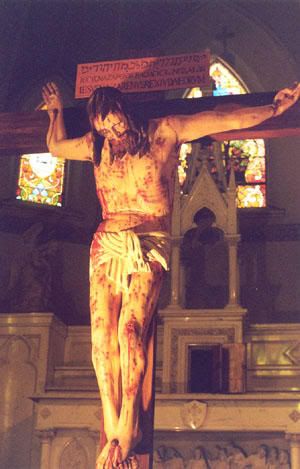
I had never seen any other images of this crucifix but this one. But completely by accident, I stumbled across more information about it. It is housed at St. Peter's Catholic Church, in Harper's Ferry, West Virginia, a church which survived John Brown's raid and the Civil War. The crucifix has been there since 1995.

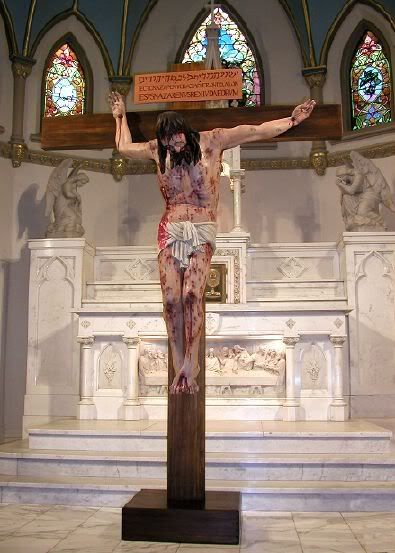
Close-up of the sign
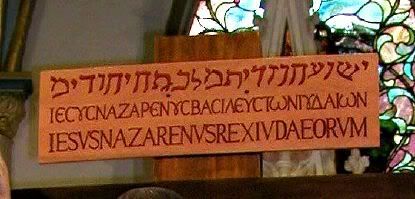
I have used this image of a crucifix based on the Wounds of Our Lord seen on the Holy Shroud of Turin several times. It is, in fact, my favorite crucifix.

I had never seen any other images of this crucifix but this one. But completely by accident, I stumbled across more information about it. It is housed at St. Peter's Catholic Church, in Harper's Ferry, West Virginia, a church which survived John Brown's raid and the Civil War. The crucifix has been there since 1995.


Close-up of the sign

I Am Not A Heretic
You scored as Chalcedon compliant. You are Chalcedon compliant. Congratulations, you're not a heretic. You believe that Jesus is truly God and truly man and like us in every respect, apart from sin. Officially approved in 451.
Are you a heretic? created with QuizFarm.com |
Second Sunday Of Lent
Station Church: S. Maria in Domenica alla Navicella
Devotions for a Lenten Sunday Holy Hour:
Divine Mercy Chaplet
Seven Penitential Psalms
Prayer of St. Thomas More
Psalter of St. Jerome
Threnus Prayer of St. Augustine
From The Liturgical Year, by Abbot Prosper Gueranger, OSB:
THE subject offered to our consideration, on this second Sunday, is one of the utmost importance for the holy season. The Church applies to us the lesson which our Saviour gave to three of His apostles. Let us endeavour to be more attentive to it than they were.
Jesus was about to pass from Galilee into Judea, that He might go up to Jerusalem and be present at the feast of the Pasch. It was that last Pasch, which was to begin with the immolation of the figurative lamb, and end with the sacrifice of the Lamb of God, who taketh away the sins of the world. Jesus would have His disciples know Him. His works had borne testimony to Him, even before those who were, in a manner, strangers to Him; but as for His disciples, had they not every reason to be faithful to Him, even to death? Had they not listened to His words, which had such power with them that they forced conviction? Had they not experienced His love, which it was impossible to resist? And had they not seen how patiently He had borne with their strange and untoward ways? Yes, they must have known Him. They had heard one of their company, Peter, declare that He was the Christ, the Son of the living God. [St. Matt. xvi. 16.] Notwithstanding this, the trial to which their faith was soon to be put was of such a terrible kind, that Jesus would mercifully arm them against temptation by an extraordinary grace.
The cross was to be a scandal and a stumbling-block [1 Cor. i. 23.] to the Synagogue, and alas! to more than it. Jesus said to His apostles at the last Supper: 'All of you shall be scandalized in Me this night.' [St. Matt. xxvi. 31.] Carnal-minded as they then were, what would they think when they should see Him seized by armed men, handcuffed, hurried from one tribunal to another, and doing nothing to defend Himself! And when they found that the high priests and pharisees, who had hitherto been so often foiled by the wisdom and miracles of Jesus, had now succeeded in their conspiracy against Him, what a shock to their confidence! But there was to be something more trying still: the people, who, but a few days before, greeted Him so enthusiastically with their Hosannas, would demand His execution; and He would have to die, between two thieves, on the cross, amidst the insults of His triumphant enemies.
Is it not to be feared that these disciples, when they witness His humiliations and sufferings, will lose their courage? They have lived in His company for three years; but when they see that the things He foretold would happen to Him are really fulfilled, will the remembrance of all they have seen and heard keep them loyal to Him? Or will they turn cowards and flee from Him? Jesus selects three out of the number, who are especially dear to Him: Peter, whom He has made the rock, on which His Church is to be built, and to whom He has promised the keys of the kingdom of heaven; James, the son of thunder, who is to be the first martyr of the apostolic college; and John, James's brother, and His own beloved disciple. Jesus has resolved to take them aside, and show them a glimpse of that glory, which, until the day fixed for its manifestation, He conceals from the eyes of mortals.
He therefore leaves the rest of His disciples in the plain near Nazareth, and goes in company with the three privileged ones towards a high hill called Thabor, which is a continuation of Libanus, and which the psalmist tells us was to rejoice in the name of the Lord. [Ps. lxxxviii. 13.] No sooner has He reached the summit of the mountain, than the three apostles observe a sudden change come over Him; His Face shines as the sun, and His humble garments become white as snow. They observe two venerable men approach and speak with Him upon what He is about to suffer in Jerusalem. One is Moses, the lawgiver; the other is Elias, the prophet, who was taken up from earth on a fiery chariot without having passed through the gates of death. These two great representatives of the Jewish religion, the Law and the Prophets, humbly adore Jesus of Nazareth. The three apostles are not only dazzled by the brightness which comes from their divine Master; but they are filled with such a rapture of delight, that they cannot bear the thought of leaving the place. Peter proposes to remain there for ever and build three tabernacles, for Jesus, Moses, and Elias. And while they are admiring the glorious sight, and gazing on the beauty of their Jesus' human Nature, a bright cloud overshadows them, and a voice is heard speaking to them: it is the voice of the eternal Father, proclaiming the Divinity of Jesus, and saying: 'This is My beloved Son!'
This transfiguration of the Son of Man, this manifestation of His glory, lasted but a few moments: His mission was not on Thabor; it was humiliation and suffering in Jerusalem. He therefore withdrew into Himself the brightness He had allowed to transpire; and when He came to the three apostles, who, on hearing the voice from the cloud, had fallen on their faces with fear, they could see no one save only Jesus. The bright cloud was gone; Moses and Elias had disappeared. What a favour they have had bestowed upon them! Will they remember what they have seen and heard? They have had such a revelation of the Divinity of their dear Master! Is it possible that, when the hour of trial comes, they will forget it, and doubt His being God? And when they see Him suffer and die, will they be ashamed of Him and deny Him? Alas! the Gospel has told us what happened to them.
A short time after this, our Lord celebrated His last Supper with His disciples. When the supper was over, He took them to another mount, Mount Olivet, which lies to the east of Jerusalem. Leaving the rest at the entrance of the garden, He advances with Peter, James, and John, and then says to them: 'My soul is sorrowful even unto death: stay you here and watch with Me.' [St. Matt. xxvi. 38.] He then retires some little distance from them, and prays to His eternal Father. The Heart of our Redeemer is weighed down with anguish. When He returns to His three disciples, He is enfeebled by the agony He has suffered, and His garments are saturated with Blood. The apostles are aware that He is sad even unto death, and that the hour is close at hand when He is to be attacked: are they keeping watch? are they ready to defend Him? No: they seem to have forgotten Him; they are fast asleep, for their eyes are heavy. [Ibid. 43.] Yet a few moments, and all will have fled from Him; and Peter, the bravest of them all, will be taking his oath that he never knew the Man.
After the Resurrection our three apostles made ample atonement for this cowardly and sinful conduct, and acknowledged the mercy wherewith Jesus had sought to fortify them against temptation, by showing them His glory on Thabor a few days before His Passion. Let us not wait till we have betrayed Him: let us at once acknowledge that He is our Lord and our God. We are soon to be keeping the anniversary of His Sacrifice; like the apostles, we are to see Him humbled by His enemies and bearing, in our stead, the chastisements of divine justice. We must not allow our faith to be weakened, when we behold the fulfilment of those prophecies of David and Isaias, that the Messias is to be treated as a worm of the earth, [Ps. xxi. 7.] and be covered with wounds, so as to become like a leper, the most abject of men, and the Man of sorrows. [Is. liii. 3. 4.] We must remember the grand things of Thabor, and the adorations paid Him by Moses and Elias, and the bright cloud, and the voice of the eternal Father. The more we see Him humbled, the more must we proclaim His glory and divinity; we, must join our acclamations with those of the angels and the four-and-twenty elders, whom St. John, one of the witnesses of the Transfiguration, heard crying out with a loud voice: 'The Lamb that was slain, is worthy to receive power and divinity, and wisdom, and strength, and honour, and glory, and benediction!' [Apoc. v. 12.]
The second Sunday of Lent is called, from the first word of the Introit, Reminiscere; and also Transfiguration-Sunday, on account of the Gospel which is read in the Mass.
The Station at Rome is in the church of St. Mary in Dominica, on Monte Celio. Tradition tells us that in this basilica was the diaconicum of which St. Laurence had charge, and from which he distributed to the poor the alms of the Church.
Devotions for a Lenten Sunday Holy Hour:
Divine Mercy Chaplet
Seven Penitential Psalms
Prayer of St. Thomas More
Psalter of St. Jerome
Threnus Prayer of St. Augustine
From The Liturgical Year, by Abbot Prosper Gueranger, OSB:
THE subject offered to our consideration, on this second Sunday, is one of the utmost importance for the holy season. The Church applies to us the lesson which our Saviour gave to three of His apostles. Let us endeavour to be more attentive to it than they were.
Jesus was about to pass from Galilee into Judea, that He might go up to Jerusalem and be present at the feast of the Pasch. It was that last Pasch, which was to begin with the immolation of the figurative lamb, and end with the sacrifice of the Lamb of God, who taketh away the sins of the world. Jesus would have His disciples know Him. His works had borne testimony to Him, even before those who were, in a manner, strangers to Him; but as for His disciples, had they not every reason to be faithful to Him, even to death? Had they not listened to His words, which had such power with them that they forced conviction? Had they not experienced His love, which it was impossible to resist? And had they not seen how patiently He had borne with their strange and untoward ways? Yes, they must have known Him. They had heard one of their company, Peter, declare that He was the Christ, the Son of the living God. [St. Matt. xvi. 16.] Notwithstanding this, the trial to which their faith was soon to be put was of such a terrible kind, that Jesus would mercifully arm them against temptation by an extraordinary grace.
The cross was to be a scandal and a stumbling-block [1 Cor. i. 23.] to the Synagogue, and alas! to more than it. Jesus said to His apostles at the last Supper: 'All of you shall be scandalized in Me this night.' [St. Matt. xxvi. 31.] Carnal-minded as they then were, what would they think when they should see Him seized by armed men, handcuffed, hurried from one tribunal to another, and doing nothing to defend Himself! And when they found that the high priests and pharisees, who had hitherto been so often foiled by the wisdom and miracles of Jesus, had now succeeded in their conspiracy against Him, what a shock to their confidence! But there was to be something more trying still: the people, who, but a few days before, greeted Him so enthusiastically with their Hosannas, would demand His execution; and He would have to die, between two thieves, on the cross, amidst the insults of His triumphant enemies.
Is it not to be feared that these disciples, when they witness His humiliations and sufferings, will lose their courage? They have lived in His company for three years; but when they see that the things He foretold would happen to Him are really fulfilled, will the remembrance of all they have seen and heard keep them loyal to Him? Or will they turn cowards and flee from Him? Jesus selects three out of the number, who are especially dear to Him: Peter, whom He has made the rock, on which His Church is to be built, and to whom He has promised the keys of the kingdom of heaven; James, the son of thunder, who is to be the first martyr of the apostolic college; and John, James's brother, and His own beloved disciple. Jesus has resolved to take them aside, and show them a glimpse of that glory, which, until the day fixed for its manifestation, He conceals from the eyes of mortals.
He therefore leaves the rest of His disciples in the plain near Nazareth, and goes in company with the three privileged ones towards a high hill called Thabor, which is a continuation of Libanus, and which the psalmist tells us was to rejoice in the name of the Lord. [Ps. lxxxviii. 13.] No sooner has He reached the summit of the mountain, than the three apostles observe a sudden change come over Him; His Face shines as the sun, and His humble garments become white as snow. They observe two venerable men approach and speak with Him upon what He is about to suffer in Jerusalem. One is Moses, the lawgiver; the other is Elias, the prophet, who was taken up from earth on a fiery chariot without having passed through the gates of death. These two great representatives of the Jewish religion, the Law and the Prophets, humbly adore Jesus of Nazareth. The three apostles are not only dazzled by the brightness which comes from their divine Master; but they are filled with such a rapture of delight, that they cannot bear the thought of leaving the place. Peter proposes to remain there for ever and build three tabernacles, for Jesus, Moses, and Elias. And while they are admiring the glorious sight, and gazing on the beauty of their Jesus' human Nature, a bright cloud overshadows them, and a voice is heard speaking to them: it is the voice of the eternal Father, proclaiming the Divinity of Jesus, and saying: 'This is My beloved Son!'
This transfiguration of the Son of Man, this manifestation of His glory, lasted but a few moments: His mission was not on Thabor; it was humiliation and suffering in Jerusalem. He therefore withdrew into Himself the brightness He had allowed to transpire; and when He came to the three apostles, who, on hearing the voice from the cloud, had fallen on their faces with fear, they could see no one save only Jesus. The bright cloud was gone; Moses and Elias had disappeared. What a favour they have had bestowed upon them! Will they remember what they have seen and heard? They have had such a revelation of the Divinity of their dear Master! Is it possible that, when the hour of trial comes, they will forget it, and doubt His being God? And when they see Him suffer and die, will they be ashamed of Him and deny Him? Alas! the Gospel has told us what happened to them.
A short time after this, our Lord celebrated His last Supper with His disciples. When the supper was over, He took them to another mount, Mount Olivet, which lies to the east of Jerusalem. Leaving the rest at the entrance of the garden, He advances with Peter, James, and John, and then says to them: 'My soul is sorrowful even unto death: stay you here and watch with Me.' [St. Matt. xxvi. 38.] He then retires some little distance from them, and prays to His eternal Father. The Heart of our Redeemer is weighed down with anguish. When He returns to His three disciples, He is enfeebled by the agony He has suffered, and His garments are saturated with Blood. The apostles are aware that He is sad even unto death, and that the hour is close at hand when He is to be attacked: are they keeping watch? are they ready to defend Him? No: they seem to have forgotten Him; they are fast asleep, for their eyes are heavy. [Ibid. 43.] Yet a few moments, and all will have fled from Him; and Peter, the bravest of them all, will be taking his oath that he never knew the Man.
After the Resurrection our three apostles made ample atonement for this cowardly and sinful conduct, and acknowledged the mercy wherewith Jesus had sought to fortify them against temptation, by showing them His glory on Thabor a few days before His Passion. Let us not wait till we have betrayed Him: let us at once acknowledge that He is our Lord and our God. We are soon to be keeping the anniversary of His Sacrifice; like the apostles, we are to see Him humbled by His enemies and bearing, in our stead, the chastisements of divine justice. We must not allow our faith to be weakened, when we behold the fulfilment of those prophecies of David and Isaias, that the Messias is to be treated as a worm of the earth, [Ps. xxi. 7.] and be covered with wounds, so as to become like a leper, the most abject of men, and the Man of sorrows. [Is. liii. 3. 4.] We must remember the grand things of Thabor, and the adorations paid Him by Moses and Elias, and the bright cloud, and the voice of the eternal Father. The more we see Him humbled, the more must we proclaim His glory and divinity; we, must join our acclamations with those of the angels and the four-and-twenty elders, whom St. John, one of the witnesses of the Transfiguration, heard crying out with a loud voice: 'The Lamb that was slain, is worthy to receive power and divinity, and wisdom, and strength, and honour, and glory, and benediction!' [Apoc. v. 12.]
The second Sunday of Lent is called, from the first word of the Introit, Reminiscere; and also Transfiguration-Sunday, on account of the Gospel which is read in the Mass.
The Station at Rome is in the church of St. Mary in Dominica, on Monte Celio. Tradition tells us that in this basilica was the diaconicum of which St. Laurence had charge, and from which he distributed to the poor the alms of the Church.


